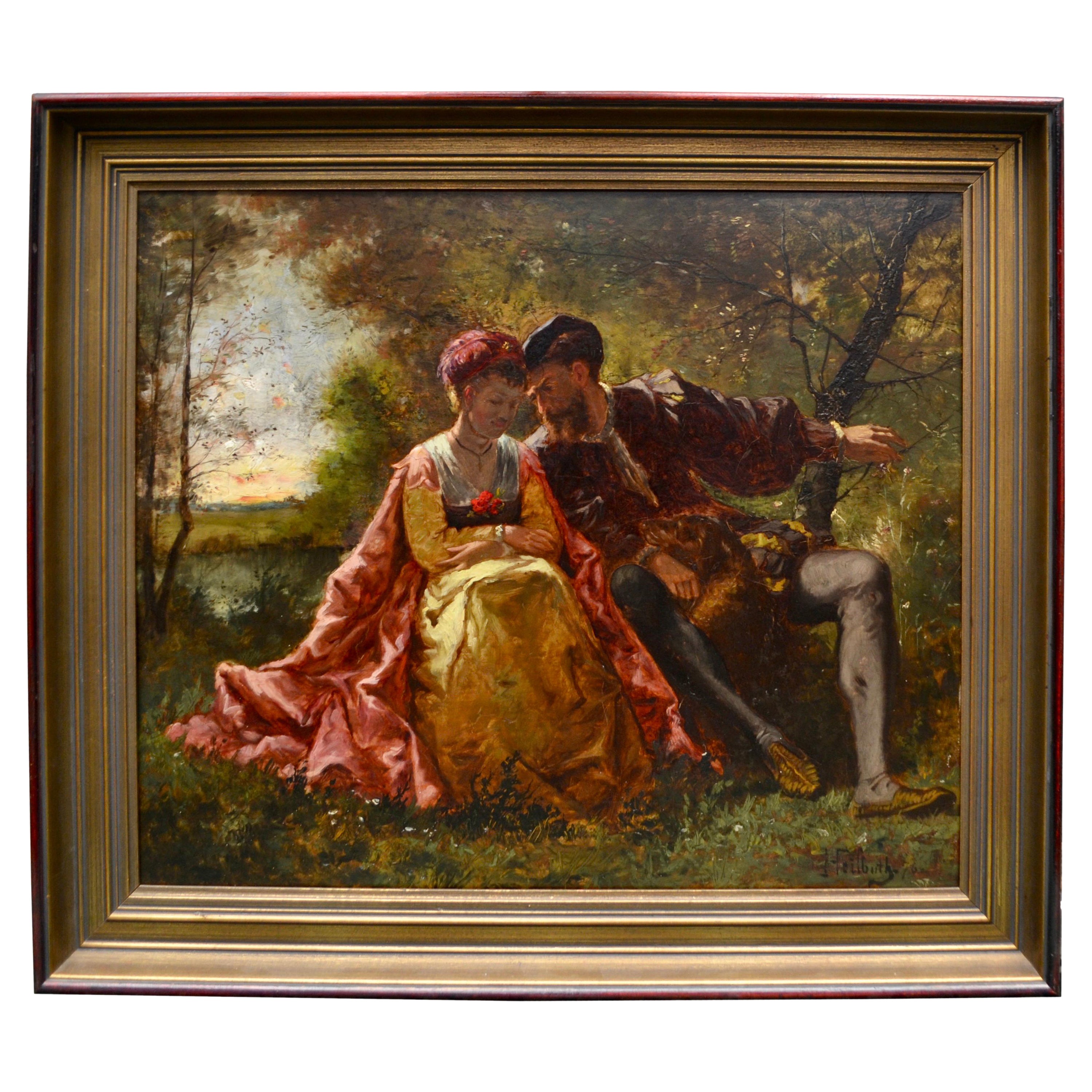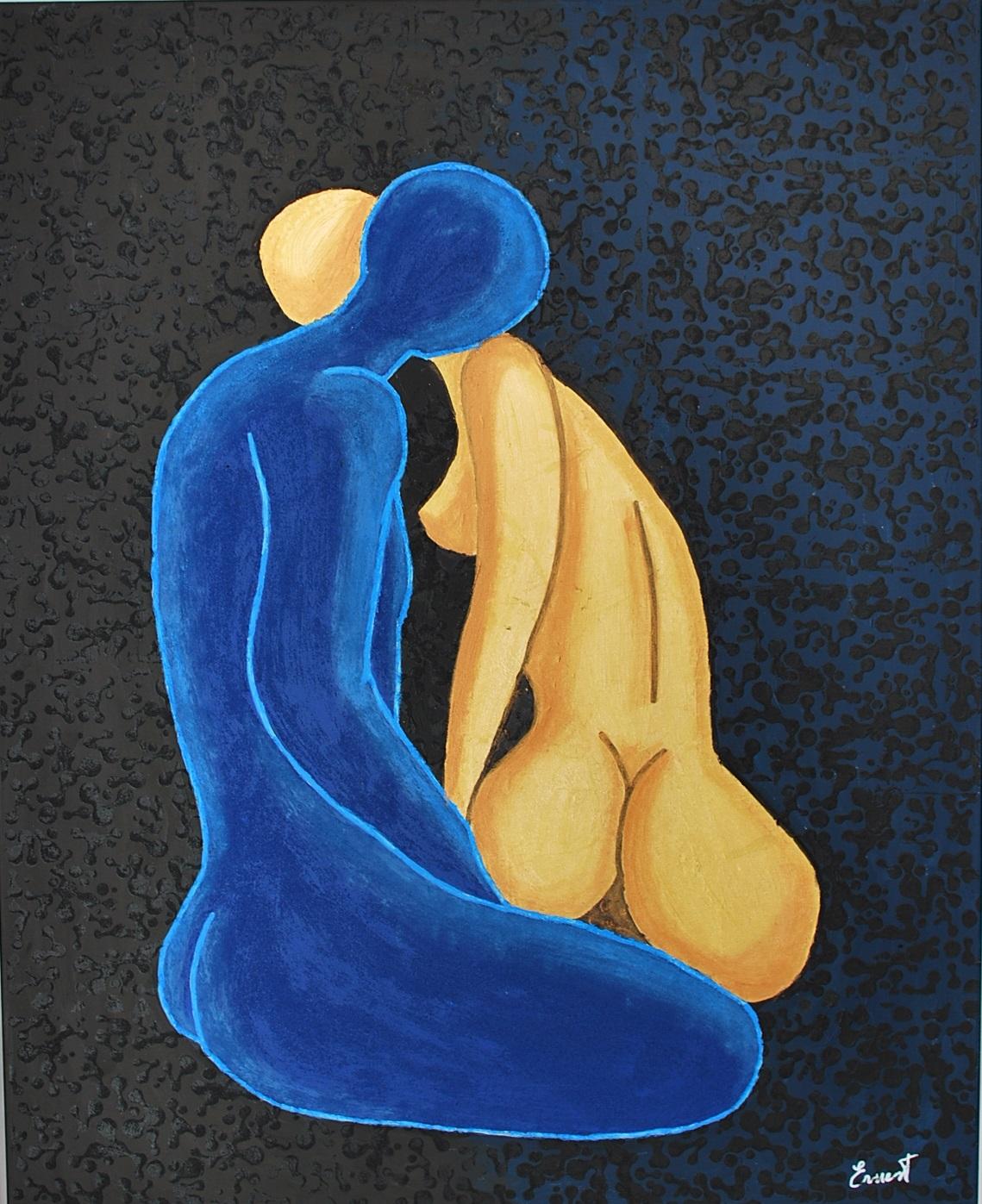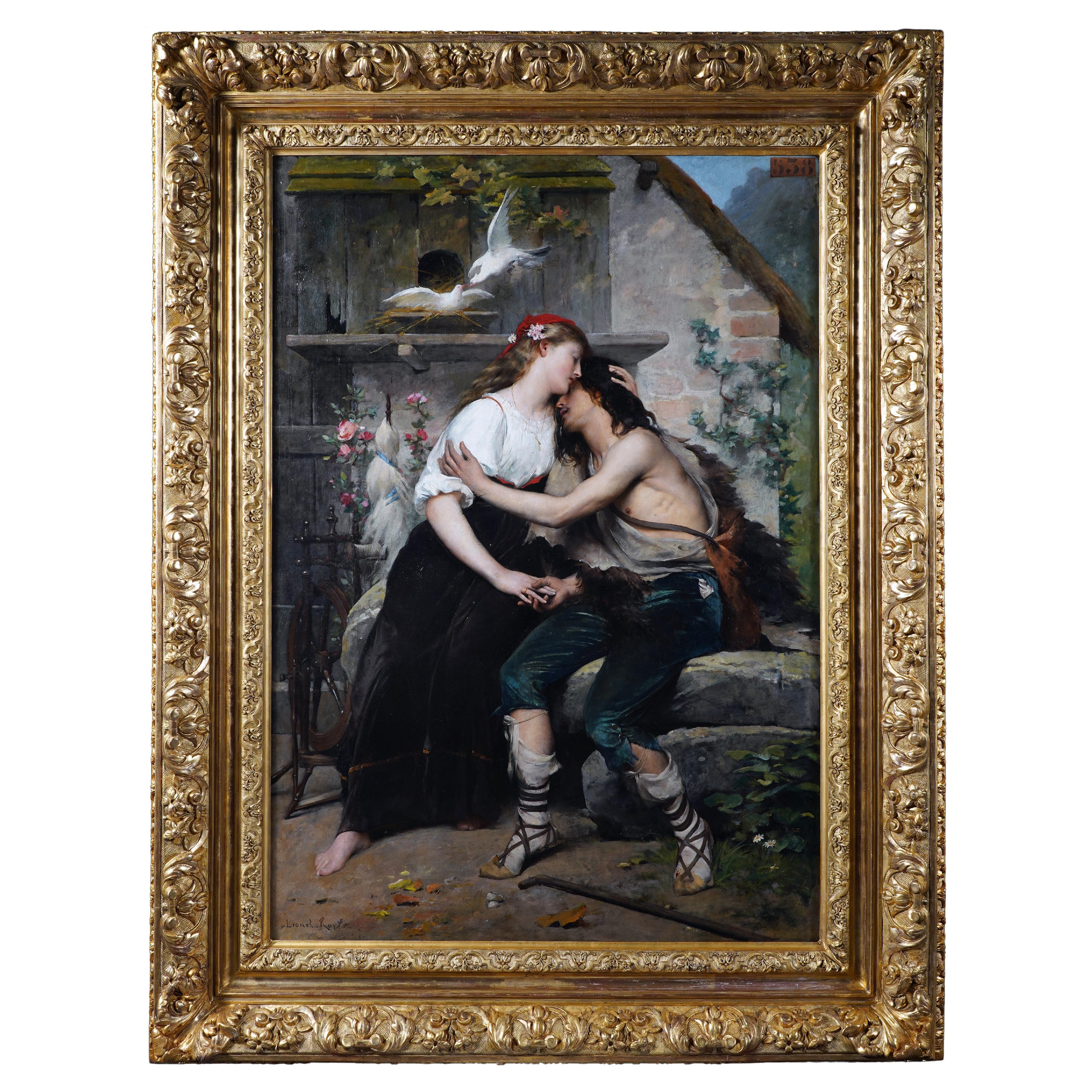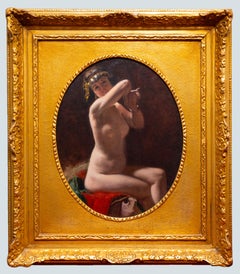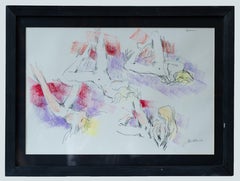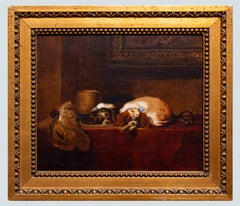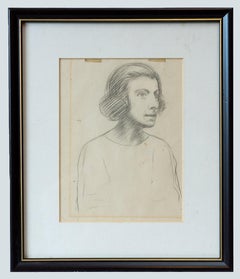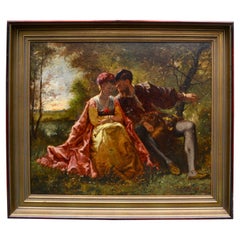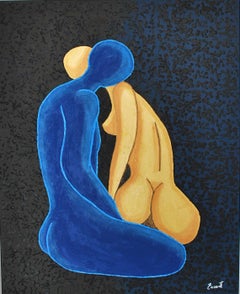Items Similar to Irma Martin, "Ondine" couple lovers
Want more images or videos?
Request additional images or videos from the seller
1 of 8
Irma Martin Irma Martin, "Ondine" couple lovers1840s
1840s
$4,149.21
£3,000
€3,544.87
CA$5,734.83
A$6,377.51
CHF 3,346.72
MX$77,770.70
NOK 42,303.76
SEK 39,661.46
DKK 26,458.47
About the Item
Irma Martin (1814–1876): A Woman Painter in the 19th Century
Irma Martin, born Anne Pierrette Marie Martin on September 3, 1814, in Lyon, emerged as a professional painter in a time when women artists faced significant social and institutional barriers. Opportunities for formal art education were limited for women in 19th-century France, and entry into prestigious exhibitions like the Paris Salon was a formidable challenge. Despite this, Martin carved out a notable artistic career, earning a reputation as a skilful painter of historical, religious, and genre scenes.
Martin studied painting in Paris under Charles de Steuben, a respected history painter of German origin. De Steuben was associated with the Romantic movement and had close ties to the École des Beaux-Arts. As a pupil in his atelier, Martin would have received a solid academic foundation in drawing, composition, and history painting—a rarity for women of her era. Upon his death, she reportedly took over leadership of his studio, an exceptional achievement that illustrates her professional competence and the respect she earned among her peers.
Irma Martin made her debut at the Salon de Paris in 1837—one of the most prestigious art exhibitions in France—where she exhibited Édouard IV chez Elisabeth Gray. The work earned her a medal, a significant recognition at a time when women artists were rarely awarded such honours. Her inclusion in the Salon was a remarkable success for a woman artist, especially in a system dominated by male academicians who often regarded female painters as amateurs.
She continued to exhibit at the Salon throughout the 1840s, presenting works that demonstrated her command of historical and biblical themes—genres traditionally reserved for men. Among her most prominent Salon pieces was Les Trois Femmes au Tombeau du Christ (The Three Women at the Tomb of Christ), shown in 1843. This large religious composition tackled one of Christianity’s most poignant episodes, rendered with dramatic pathos and fine attention to facial expression and gesture. The painting was later sold at auction, reflecting sustained interest in her work.
In 1864, Martin returned to Lyon and participated in an exhibition organized by the Société des Amis des Arts, presenting a pastel titled La Lecture. Even in her later years, she remained active in the art world and continued to explore various media. She died in Mâcon, France, on May 19, 1876.
Irma Martin’s career must be viewed through the lens of her gender. The 19th century was a time when female artists were largely excluded from formal institutions like the Académie des Beaux-Arts and were often denied the rigorous training necessary for success in history painting—the highest and most respected genre. Martin defied this norm by not only receiving serious training but excelling in narrative compositions that demanded technical and intellectual sophistication.
That she succeeded in entering the Paris Salon and gaining critical recognition places her among the vanguard of 19th-century women artists, alongside contemporaries like Rosa Bonheur and Léonide Gachet. Martin’s persistence and achievements testify to the broader struggles—and quiet triumphs—of women artists working within the confines of a patriarchal cultural system.
Ondine (1842)
Our painting of Ondine seems to be another version the painting exhibited at the Salon.
One of Irma Martin’s most evocative and intriguing works is Ondine donne à son époux le baiser qui doit le faire mourir (Ondine Gives Her Husband the Kiss That Will Cause His Death), exhibited at the Salon of 1842. The painting draws from the European Romantic fascination with myth, particularly the legend of Ondine, a water spirit or nymph derived from Germanic folklore.
In the Ondine legend, the titular character marries a mortal man and is granted a soul through the union. However, this gift comes with a tragic condition: if her husband proves unfaithful, she must kill him with a kiss. The story gained widespread popularity in Romantic literature and art for its exploration of passion, betrayal, and the supernatural.
Martin depicted the climactic moment of the fatal kiss: Ondine, ethereal and sorrowful, poised to deliver a kiss that is both an act of love and a death sentence. The setting would likely be aquatic or nocturnal, using cool tones to emphasize the water nymph’s connection to the natural world and her otherworldly presence.
Martin’s ability to convey complex emotional states—grief, love, inevitability—is key to the painting’s power. The figure of Ondine has been painted with delicate, almost translucent skin, surrounded by flowing drapery an hair suggestive of waves. Her mortal husband, caught in a moment of vulnerability, would serve as a foil to her divine but tragic power.
The painting reflects Romanticism’s broader interest in mythological and supernatural subjects, especially those involving doomed or transcendent love. Female artists often gravitated toward these themes, which allowed for both emotional expression and subtle commentary on the constraints placed on women’s agency and desire.
By choosing such a subject, Martin aligned herself with the Romantic movement while also asserting a unique female perspective on a myth centered around feminine power and sacrifice. In Ondine, we see a woman both as a victim of her destiny and as an active agent in shaping it—perhaps a metaphor for Martin herself.
- Creator:Irma Martin (1814 - 1876, French)
- Creation Year:1840s
- Dimensions:Height: 33.47 in (85 cm)Width: 27.17 in (69 cm)
- Medium:
- Movement & Style:
- Period:
- Framing:Frame IncludedFraming Options Available
- Condition:
- Gallery Location:London, GB
- Reference Number:Seller: 151stDibs: LU2841216327182
About the Seller
New to 1stDibs
Joined in the past six months.
No Reviews Yet
Vetted Professional Seller
Every seller passes strict standards for authenticity and reliability
1stDibs seller since 2025
- ShippingRetrieving quote...Shipping from: London, United Kingdom
- Return Policy
Authenticity Guarantee
In the unlikely event there’s an issue with an item’s authenticity, contact us within 1 year for a full refund. DetailsMoney-Back Guarantee
If your item is not as described, is damaged in transit, or does not arrive, contact us within 7 days for a full refund. Details24-Hour Cancellation
You have a 24-hour grace period in which to reconsider your purchase, with no questions asked.Vetted Professional Sellers
Our world-class sellers must adhere to strict standards for service and quality, maintaining the integrity of our listings.Price-Match Guarantee
If you find that a seller listed the same item for a lower price elsewhere, we’ll match it.Trusted Global Delivery
Our best-in-class carrier network provides specialized shipping options worldwide, including custom delivery.More From This Seller
View AllOdalisque, by Georges Philippe Jacqmotte (1876–1949), signed and dated
Located in London, GB
Orientalist painting by Georges Philippe Jacqmotte (1876–1949), a Belgian painter known for his Impressionist landscapes and still lifes.
'Odalisque' is the French term odalisque c...
Category
Late 19th Century Figurative Paintings
Materials
Canvas, Oil
Life study of Sylviane
By Peter Collins ARCA
Located in London, GB
Born in London in 1923, Collins began his artistic journey working in a commercial studio while attending evening classes at art school. His education was interrupted by World War II...
Category
20th Century Modern Figurative Paintings
Materials
Pastel, Archival Paper, Color Pencil
Two resting dogs, after Sir Edwin Henry Landseer RA
By Sir Edwin Henry Landseer, 1802-1873
Located in London, GB
This painting after Edwin Henry Landseer RA (7 March 1802 – 1 October 1873) shows two dogs which were among Landseer’s favorite subjects. They are rendered in a naturalistic and expr...
Category
20th Century Animal Paintings
Materials
Canvas, Oil
Portrait of a woman, signed "Frank Jameson" in the back (1898-1968)
By Frank Jameson
Located in London, GB
This finely rendered pencil drawing by British artist Frank Jameson depicts a contemplative female sitter in three-quarter view. Executed with delicate, confident linework and subtle...
Category
20th Century Portrait Paintings
Materials
Paper, Pencil
A lady in conversation with a glove. 19th century oil on board. English school
Located in London, GB
A 19th century painting of a lady and a man in conversation.
In a quiet, sunlit drawing room, a young lady sits by the window, bathed in the soft, diffused light of a late afternoon...
Category
19th Century English School Figurative Paintings
Materials
Oil, Board
Salmon by the River, John Peter Russell, signed
Located in London, GB
John Peter Russell was a pioneering Australian impressionist, born in Sydney in 1858. After studying engineering in England, he turned to art and trained at the Académie Julian in Pa...
Category
Late 19th Century Animal Paintings
Materials
Oil, Board
You May Also Like
Romantic Scene - Italian Figurative Oil on Canvas Painting
Located in Napoli, IT
Romantic Scene - Figurative Oil on canvas painting cm.100x80
this painting is a reinterpretation of the painting 'a Cautious Approach' by Master Roberts ...
Category
Early 2000s English School Figurative Paintings
Materials
Canvas, Oil
Oil Painting Pair by Alessandro Sani "Flirtation"
Located in Mere, GB
Oil Painting Pair by Alessandro Sani "Flirtation" 1856 - 1927. Italian painter of domestic and historical scenes and professor of Art. Based in Flore...
Category
1890s Figurative Paintings
Materials
Oil
$6,915 Sale Price
35% Off
"Lovers in the Park” by German/French Artist Ferdinand Heilbuth
By Ferdinand Heilbuth
Located in Vancouver, British Columbia
A Classic romantic movement oil painting on wood panel depicting two lovers. They are dressed in Renaissance almost theatrical garments and they sit intimately close to one another on a bench. The atmospheric background is set in the middle of a wooded park in the early evening hours before dusk. Their faces are almost in shadow as the brilliant orange/red sun sets behind them. The painting is signed F. Heilbuth on the right hand bottom corner of the canvas and is dated ’76 in reference to 1876. It is set in a gold painted wood frame.
Biography
Ferdinand Heilbuth, (1826-1889), was a German-born French painter. He was born in Hamburg in 1826, and died in Paris in 1889 having become a French citizen in 1876, the same year he painted this work. He is buried in Père-Lachaise cemetery in Paris.
This genre painter whose talent has the characteristics of nobility, liveliness of color and accent in expression, exhibited many times at the Royal Academy in London. His works were also shown in the Grosvenor Gallery...
Category
Antique Late 19th Century French Romantic Paintings
Materials
Canvas
PAREJA DE AMANTES 1
Located in Barcelona, BARCELONA
In the work we can see a naked couple in what appears to be the beginning of sexual relations.
Category
2010s Naturalistic Figurative Paintings
Materials
Canvas, Acrylic
Les deux amours punis
Located in Atlanta, GA
Gustave Doyen (1836 in Festieux – 1923 in Fontainebleau) was a French painter working during 19th and 20th centuries in France. He was educated at St Edmund's College in Douai and trained by William...
Category
19th Century Expressionist Figurative Paintings
Materials
Oil
L. Royer, Oil on canvas "Thwarted Love" , France, dated 1882 (?)
Located in PARIS, FR
Signed Lionel Royer and dated 1882 (?)
Former Salon exhibition label at the top right, n°538
Indication of an exhibition in Lyon on the back of the frame, n°163
Beautiful painting ...
Category
Antique 1880s French Romantic Paintings
Materials
Canvas
More Ways To Browse
Le Couple
Dior Christal
Love And Sacrifice
Chez Antique
Antique Religious Medals
19th Century Painting Lovers
Water Nymph
Antique Foil Art
Kissing Couple
19th Century Male Oil Paintings
19th Century French Religious Oil Painting
Antique Steuben
Rosa Bonheur Painting
Blue Tit
Ferris Wheel
Hong Kong Original Poster
Maharaja Paintings
Marvel Comic Art

